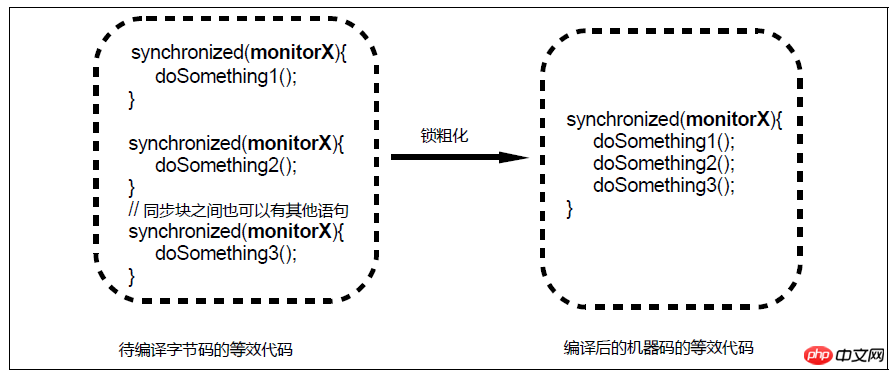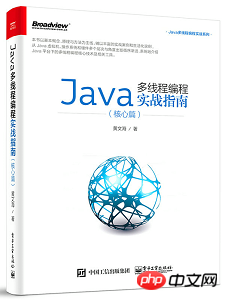Analysis of four ways to optimize internal locks in Java virtual machine
This article mainly introduces the four optimization methods of Java virtual machine for internal locks. The editor thinks it is quite good. Now I will share it with you and give you a reference. Let’s follow the editor to take a look
Since Java 6/Java 7, the Java virtual machine has made some optimizations to the implementation of internal locks. These optimizations mainly include Lock Elision, Lock Coarsening, Biased Locking and Adaptive Locking. These optimizations only work in the Java virtual machine server mode (that is, when running a Java program, we may need to specify the Java virtual machine parameter "-server" on the command line to turn on these optimizations).
1 Lock Elimination
Lock Elision is an optimization made by the JIT compiler on the specific implementation of internal locks.

Schematic diagram of Lock Elision
When dynamically compiling synchronized blocks, the JIT compiler can use a method called escape analysis (Escape Analysis) technology to determine whether the lock object used by the synchronized block can only be accessed by one thread and has not been released to other threads. If the lock object used by the synchronized block is confirmed to be accessible by only one thread through this analysis, then the JIT compiler will not generate the machine code corresponding to the lock application and release represented by synchronized when compiling the synchronized block, but Only the machine code corresponding to the original critical section code is generated, which causes the dynamically compiled bytecode to look like it does not contain the two bytecode instructions monitorenter (apply for lock) and monitorexit (release lock), that is, eliminate Use of locks. This compiler optimization is called Lock Elision, which allows us to completely eliminate lock overhead under certain circumstances.
Although some classes in the Java standard library (such as StringBuffer) are thread-safe, in actual use we often do not share instances of these classes between multiple threads. These classes often rely on internal locks when implementing thread safety. Therefore, these classes are common targets for lock elimination optimizations.
Listing 12-1 Sample code that can be optimized for lock elimination
public class LockElisionExample {
public static String toJSON(ProductInfo productInfo) {
StringBuffer sbf = new StringBuffer();
sbf.append("{\"productID\":\"").append(productInfo.productID);
sbf.append("\",\"categoryID\":\"").append(productInfo.categoryID);
sbf.append("\",\"rank\":").append(productInfo.rank);
sbf.append(",\"inventory\":").append(productInfo.inventory);
sbf.append('}');
return sbf.toString();
}
}In the above example, the JIT compiler is compiling the toJSON method The StringBuffer.append/toString method it calls will be inlined into the method. This is equivalent to copying the instructions in the method body of the StringBuffer.append/toString method to the toJSON method body. The StringBuffer instance sbf here is a local variable, and the object referenced by this variable is not published to other threads. Therefore, the object referenced by sbf can only be accessed by the current execution thread (one thread) of the method where sbf is located (toJSON method). . Therefore, the JIT compiler can now eliminate the internal lock used by the instructions in the toJSON method that are copied from the method body of the StringBuffer.append/toString method. In this example, the lock used by the StringBuffer.append/toString method itself will not be released, because there may be other places in the system that use StringBuffer, and these codes may share StringBuffer instances.
The escape analysis technology that lock elimination optimization relies on is enabled by default since Java SE 6u23, but lock elimination optimization was introduced in Java 7.
As can be seen from the above examples, lock elimination optimization may also require inline optimization of the JIT compiler. Whether a method will be inlined by the JIT compiler depends on the popularity of the method and the size of the bytecode corresponding to the method (Bytecode Size). Therefore, whether lock elimination optimization can be implemented also depends on whether the called synchronized method (or method with synchronized block) can be inlined.
Lock elimination optimization tells us that we must use locks when we should use locks, without paying too much attention to the cost of locks. Developers should consider whether locking is needed at the logical level of the code. As for whether a lock is really necessary at the code running level, it is decided by the JIT compiler. Lock elimination optimization does not mean that developers can use internal locks at will when writing code (locking when locking is not required), because lock elimination is an optimization done by the JIT compiler rather than javac, and a paragraph Code can only be optimized by the JIT compiler if it is executed frequently enough. That is to say, before the JIT compiler optimization intervenes, as long as the internal lock is used in the source code, the overhead of this lock will exist. In addition, the inline optimization, escape analysis, and lock elimination optimization performed by the JIT compiler all have their own overhead.
Under the effect of lock elimination, using ThreadLocal to use a thread-safe object (such as Random) as a thread-specific object can not only avoid lock contention, but also completely eliminate the internal problems of these objects. The overhead of the lock used.
2 Lock coarsening
Lock coarsening (Lock Coarsening/Lock Merging) is an optimization made by the JIT compiler on the specific implementation of internal locks.

Lock Coarsening diagram
对于相邻的几个同步块,如果这些同步块使用的是同一个锁实例,那么JIT编译器会将这些同步块合并为一个大同步块,从而避免了一个线程反复申请、释放同一个锁所导致的开销。然而,锁粗化可能导致一个线程持续持有一个锁的时间变长,从而使得同步在该锁之上的其他线程在申请锁时的等待时间变长。例如上图中,第1个同步块结束和第2个同步块开始之间的时间间隙中,其他线程本来是有机会获得monitorX的,但是经过锁粗化之后由于临界区的长度变长,这些线程在申请monitorX时所需的等待时间也相应变长了。因此,锁粗化不会被应用到循环体内的相邻同步块。
相邻的两个同步块之间如果存在其他语句,也不一定就会阻碍JIT编译器执行锁粗化优化,这是因为JIT编译器可能在执行锁粗化优化前将这些语句挪到(即指令重排序)后一个同步块的临界区之中(当然,JIT编译器并不会将临界区内的代码挪到临界区之外)。
实际上,我们写的代码中可能很少会出现上图中那种连续的同步块。这种同一个锁实例引导的相邻同步块往往是JIT编译器编译之后形成的。
例如,在下面的例子中
清单12-2 可进行锁粗化优化的示例代码
public class LockCoarseningExample {
private final Random rnd = new Random();
public void simulate() {
int iq1 = randomIQ();
int iq2 = randomIQ();
int iq3 = randomIQ();
act(iq1, iq2, iq3);
}
private void act(int... n) {
// ...
}
// 返回随机的智商值
public int randomIQ() {
// 人类智商的标准差是15,平均值是100
return (int) Math.round(rnd.nextGaussian() * 15 + 100);
}
// ...
}simulate方法连续调用randomIQ方法来生成3个符合正态分布(高斯分布)的随机智商(IQ)。在simulate方法被执行得足够频繁的情况下,JIT编译器可能对该方法执行一系优化:首先,JIT编译器可能将randomIQ方法内联(inline)到simulate方法中,这相当于把randomIQ方法体中的指令复制到simulate方法之中。在此基础上,randomIQ方法中的rnd.nextGaussian()调用也可能被内联,这相当于把Random.nextGaussian()方法体中的指令复制到simulate方法之中。Random.nextGaussian()是一个同步方法,由于Random实例rnd可能被多个线程共享(因为simulate方法可能被多个线程执行),因此JIT编译器无法对Random.nextGaussian()方法本身执行锁消除优化,这使得被内联到simulate方法中的Random.nextGaussian()方法体相当于一个由rnd引导的同步块。经过上述优化之后,JIT编译器便会发现simulate方法中存在3个相邻的由rnd(Random实例)引导的同步块,于是锁粗化优化便“粉墨登场”了。
锁粗化默认是开启的。如果要关闭这个特性,我们可以在Java程序的启动命令行中添加虚拟机参数“-XX:-EliminateLocks”(开启则可以使用虚拟机参数“-XX:+EliminateLocks”)。
3 偏向锁
偏向锁(Biased Locking)是Java虚拟机对锁的实现所做的一种优化。这种优化基于这样的观测结果(Observation):大多数锁并没有被争用(Contented),并且这些锁在其整个生命周期内至多只会被一个线程持有。然而,Java虚拟机在实现monitorenter字节码(申请锁)和monitorexit字节码(释放锁)时需要借助一个原子操作(CAS操作),这个操作代价相对来说比较昂贵。因此,Java虚拟机会为每个对象维护一个偏好(Bias),即一个对象对应的内部锁第1次被一个线程获得,那么这个线程就会被记录为该对象的偏好线程(Biased Thread)。这个线程后续无论是再次申请该锁还是释放该锁,都无须借助原先(指未实施偏向锁优化前)昂贵的原子操作,从而减少了锁的申请与释放的开销。
然而,一个锁没有被争用并不代表仅仅只有一个线程访问该锁,当一个对象的偏好线程以外的其他线程申请该对象的内部锁时,Java虚拟机需要收回(Revoke)该对象对原偏好线程的“偏好”并重新设置该对象的偏好线程。这个偏好收回和重新分配过程的代价也是比较昂贵的,因此如果程序运行过程中存在比较多的锁争用的情况,那么这种偏好收回和重新分配的代价便会被放大。有鉴于此,偏向锁优化只适合于存在相当大一部分锁并没有被争用的系统之中。如果系统中存在大量被争用的锁而没有被争用的锁仅占极小的部分,那么我们可以考虑关闭偏向锁优化。
偏向锁优化默认是开启的。要关闭偏向锁优化,我们可以在Java程序的启动命令行中添加虚拟机参数“-XX:-UseBiasedLocking”(开启偏向锁优化可以使用虚拟机参数“-XX:+UseBiasedLocking”)。
4 适应性锁
适应性锁(Adaptive Locking,也被称为 Adaptive Spinning )是JIT编译器对内部锁实现所做的一种优化。
存在锁争用的情况下,一个线程申请一个锁的时候如果这个锁恰好被其他线程持有,那么这个线程就需要等待该锁被其持有线程释放。实现这种等待的一种保守方法——将这个线程暂停(线程的生命周期状态变为非Runnable状态)。由于暂停线程会导致上下文切换,因此对于一个具体锁实例来说,这种实现策略比较适合于系统中绝大多数线程对该锁的持有时间较长的场景,这样才能够抵消上下文切换的开销。另外一种实现方法就是采用忙等(Busy Wait)。所谓忙等相当于如下代码所示的一个循环体为空的循环语句:
// 当锁被其他线程持有时一直循环
while (lockIsHeldByOtherThread){}可见,忙等是通过反复执行空操作(什么也不做)直到所需的条件成立为止而实现等待的。这种策略的好处是不会导致上下文切换,缺点是比较耗费处理器资源——如果所需的条件在相当长时间内未能成立,那么忙等的循环就会一直被执行。因此,对于一个具体的锁实例来说,忙等策略比较适合于绝大多数线程对该锁的持有时间较短的场景,这样能够避免过多的处理器时间开销。
事实上,Java虚拟机也不是非要在上述两种实现策略之中择其一 ——它可以综合使用上述两种策略。对于一个具体的锁实例,Java虚拟机会根据其运行过程中收集到的信息来判断这个锁是属于被线程持有时间“较长”的还是“较短”的。对于被线程持有时间“较长”的锁,Java虚拟机会选用暂停等待策略;而对于被线程持有时间“较短”的锁,Java虚拟机会选用忙等等待策略。Java虚拟机也可能先采用忙等等待策略,在忙等失败的情况下再采用暂停等待策略。Java虚拟机的这种优化就被称为适应性锁(Adaptive Locking),这种优化同样也需要JIT编译器介入。
适应性锁优化可以是以具体的一个锁实例为基础的。也就是说,Java虚拟机可能对一个锁实例采用忙等等待策略,而对另外一个锁实例采用暂停等待策略。
从适应性锁优化可以看出,内部锁的使用并不一定会导致上下文切换,这就是我们说锁与上下文切换时均说锁“可能”导致上下文切换的原因。

The above is the detailed content of Analysis of four ways to optimize internal locks in Java virtual machine. For more information, please follow other related articles on the PHP Chinese website!

Hot AI Tools

Undresser.AI Undress
AI-powered app for creating realistic nude photos

AI Clothes Remover
Online AI tool for removing clothes from photos.

Undress AI Tool
Undress images for free

Clothoff.io
AI clothes remover

Video Face Swap
Swap faces in any video effortlessly with our completely free AI face swap tool!

Hot Article

Hot Tools

Notepad++7.3.1
Easy-to-use and free code editor

SublimeText3 Chinese version
Chinese version, very easy to use

Zend Studio 13.0.1
Powerful PHP integrated development environment

Dreamweaver CS6
Visual web development tools

SublimeText3 Mac version
God-level code editing software (SublimeText3)

Hot Topics
 1386
1386
 52
52
 Perfect Number in Java
Aug 30, 2024 pm 04:28 PM
Perfect Number in Java
Aug 30, 2024 pm 04:28 PM
Guide to Perfect Number in Java. Here we discuss the Definition, How to check Perfect number in Java?, examples with code implementation.
 Weka in Java
Aug 30, 2024 pm 04:28 PM
Weka in Java
Aug 30, 2024 pm 04:28 PM
Guide to Weka in Java. Here we discuss the Introduction, how to use weka java, the type of platform, and advantages with examples.
 Smith Number in Java
Aug 30, 2024 pm 04:28 PM
Smith Number in Java
Aug 30, 2024 pm 04:28 PM
Guide to Smith Number in Java. Here we discuss the Definition, How to check smith number in Java? example with code implementation.
 Java Spring Interview Questions
Aug 30, 2024 pm 04:29 PM
Java Spring Interview Questions
Aug 30, 2024 pm 04:29 PM
In this article, we have kept the most asked Java Spring Interview Questions with their detailed answers. So that you can crack the interview.
 Break or return from Java 8 stream forEach?
Feb 07, 2025 pm 12:09 PM
Break or return from Java 8 stream forEach?
Feb 07, 2025 pm 12:09 PM
Java 8 introduces the Stream API, providing a powerful and expressive way to process data collections. However, a common question when using Stream is: How to break or return from a forEach operation? Traditional loops allow for early interruption or return, but Stream's forEach method does not directly support this method. This article will explain the reasons and explore alternative methods for implementing premature termination in Stream processing systems. Further reading: Java Stream API improvements Understand Stream forEach The forEach method is a terminal operation that performs one operation on each element in the Stream. Its design intention is
 TimeStamp to Date in Java
Aug 30, 2024 pm 04:28 PM
TimeStamp to Date in Java
Aug 30, 2024 pm 04:28 PM
Guide to TimeStamp to Date in Java. Here we also discuss the introduction and how to convert timestamp to date in java along with examples.
 Java Program to Find the Volume of Capsule
Feb 07, 2025 am 11:37 AM
Java Program to Find the Volume of Capsule
Feb 07, 2025 am 11:37 AM
Capsules are three-dimensional geometric figures, composed of a cylinder and a hemisphere at both ends. The volume of the capsule can be calculated by adding the volume of the cylinder and the volume of the hemisphere at both ends. This tutorial will discuss how to calculate the volume of a given capsule in Java using different methods. Capsule volume formula The formula for capsule volume is as follows: Capsule volume = Cylindrical volume Volume Two hemisphere volume in, r: The radius of the hemisphere. h: The height of the cylinder (excluding the hemisphere). Example 1 enter Radius = 5 units Height = 10 units Output Volume = 1570.8 cubic units explain Calculate volume using formula: Volume = π × r2 × h (4
 Create the Future: Java Programming for Absolute Beginners
Oct 13, 2024 pm 01:32 PM
Create the Future: Java Programming for Absolute Beginners
Oct 13, 2024 pm 01:32 PM
Java is a popular programming language that can be learned by both beginners and experienced developers. This tutorial starts with basic concepts and progresses through advanced topics. After installing the Java Development Kit, you can practice programming by creating a simple "Hello, World!" program. After you understand the code, use the command prompt to compile and run the program, and "Hello, World!" will be output on the console. Learning Java starts your programming journey, and as your mastery deepens, you can create more complex applications.




